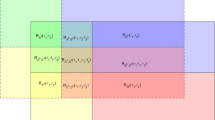Abstract
This letter presents a novel method of user selection in a downlink multi-user multiple input multiple output (MU-MIMO) system employing the precoding procedures of zero forcing or block diagonalization (BD). The proposed technique utilizes the cross-entropy method (CEM) in order to maintain a performance level comparable to that of the full search (FS) method with reasonable complexity. With the CEM, the proposed system can select multiple users at once instead of selecting a single user at each step. From various computer simulations, it has been verified that the proposed method exhibits nearly 98 % of the sum-rate compared to the FS method, which implies that the proposed method far outperforms conventional methods such as semi-orthogonal user selection (SUS) or the capacity-based suboptimal user selection (CBSUS) algorithm. Compared to CBSUS, the proposed technique enhances the sum-rate by approximately 1.1 bps/Hz with about half the complexity when each user is equipped with two receiving antennas. In the case where each user is equipped with a single antenna, the proposed method outperforms the method of SUS by about 0.3 bps/Hz, at the expense of a complexity increase of \(O(2M)\) times.






Similar content being viewed by others
References
Gesbert, D., Kountouris, M., Heath, R. W., Chae, C.-B., & Salzer, T. (2007). Shifting the MIMO paradigm. IEEE Signal Processing Magazine, 24, 36–46.
Golub, G. H., & Van Loan, C. F. (1996). Matrix computations (3rd ed.). Baltimore, MD: The John Hopkins University Press.
Jain, R., Chiu, D., & Hawe, W. (1984). A quantitative measure of fairness and discrimination for resource allocation in shared computer systems, DEC Research, Report TR-301, Sep. (1984).
Ji, T., Zhou, C., Zhou, S., et al. (2007). Low complex user selection strategies for multi-user MIMO downlink scenario. In Proceedings of the IEEE, wireless communications and networking conference (WCNC’07), pp. 1534–1539, Mar. 2007.
Jiang, J., Buehrer, R. M., & Tranter, W. H. (2006). Greedy scheduling performance for a zero-forcing dirty-paper coded system. IEEE Trans. Commun., May (2006).
Jin, L., Hu, Z., & Gu, X. (2009). “A new scheduling algorithm with low complexity for multiuser multiple-input multiple-output downlink system”, the 2009 international conference on wireless communications and signal processing (WCSP 2009). Nanjing: Nov (2009).
Junling, M. A. O., et al. (2012). Simplified semi-orthogonal user selection for MU-MIMO systems with ZFBF. IEEE in Wireless Communications Letters, 1.1, 42–45.
Lv, C., Zhou, S., Li, Y., & Wang, T. (2008). “ Low complexityscheduling technique for multiuser MIMO systems”, Vehicular Technology Conference. VTC Spring.
Rubinstein, R. Y., & Kroese, D. P. (2004). The cross-entropy method. Berlin, Germany: Springer.
Shen, Z., Chen, R., Andrews, J. G., et al. (2006). Low complexity userselection algorithms for multiuser MIMO systems with blockdiagonalization. IEEE Transactions on Signal Processing, 54(9), 3658–3663.
Spencer, Q. H., Swindlehurst, A. L., & Martin, H. (2004). Zero-forcing methods for downlink spatial multiplexing in multiuser MIMO channels. in Signal Processing IEEE Transactions on, 52(2), 461–471.
Viswanath, P., & Tse, D. N. C. (2003). Sum capacity of the vector Gaussianbroadcast channel and uplink-downlink duality. IEEE Transactions on Information Theory, 49, 1912–1921.
Yoo, T., & Goldsimth, A. (2006). On the optimality of multi-antenna broadcast scheduling using zero-forcing beamforming. IEEE Transactions on Selected Areas in Communications, 24(3), 528–541.
Acknowledgments
This research was supported by the MSIP (Ministry of Science, ICT & Future Planning), Korea, under the ITRC (Information Technology Research Center) support program (NIPA-2013- H0301-13-1001) supervised by the NIPA (National IT Industry Promotion Agency).
Author information
Authors and Affiliations
Corresponding author
Rights and permissions
About this article
Cite this article
Kim, K., Yang, H. & Choi, S. User Selection Method Adopting Cross-Entropy Method for a Downlink Multiuser MIMO System. Wireless Pers Commun 74, 789–802 (2014). https://doi.org/10.1007/s11277-013-1321-7
Published:
Issue Date:
DOI: https://doi.org/10.1007/s11277-013-1321-7




